Travel
Written by
Hugo Cannon
Sicily involves you with its captivating combination of ancient ruins, blue coasts, and colourful culture. With its rich history and magnificent surroundings, Sicily provides a unique trip in the heart of the Mediterranean.
Table of Contents:
Sicily, the largest island in the Mediterranean, is a fascinating destination rich in history and natural beauty. It is no surprise that a lot of movies and TV shows (like white lotus) have been filmed on the island considering how breathtaking every corner of Sicily is.
With a complex tapestry of civilizations that includes ancient Greek temples, Roman ruins, and Norman castles, each one tells a tale about the island's diverse history.
Its dramatic coastline is studded with lovely beaches, while rocky mountains and fertile valleys provide a breathtaking backdrop for exploring. Sicilian cuisine is a gourmet treat that includes fresh fish, savoury pasta, and sweet cannolis. From the bustling streets of Palermo to the lovely towns of Taormina, the island is rich in experiences for all types of visitors.
Best Hotels in Sicily
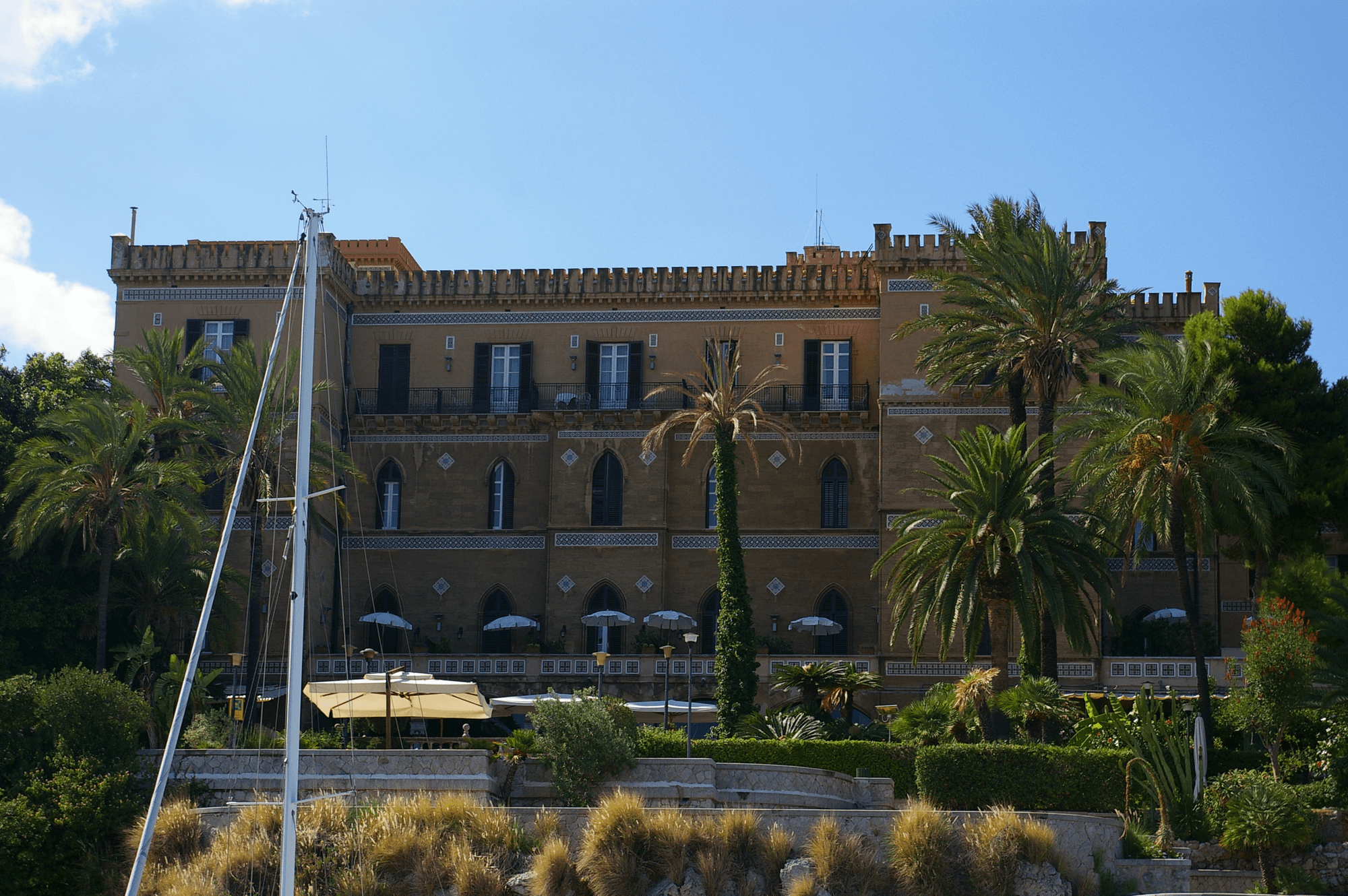
Villa Igiea
Villa Igiea
A little village on the outskirts of Palermo, noted for its fresh winds and healing springs, surrounding the villa when it was erected by Sicilian business magnate Ignazio Florio and his socialite wife, Franca. All of that has changed, and the hotel now stands in a run-down suburb above a tiny harbour.
The village of Arenella, ten minutes' walk away, has an audacious charm all its own, but you come to this hotel to enjoy the opulence within. There is a free shuttle bus service to the centre on a regular basis for people who wish to explore Palermo.
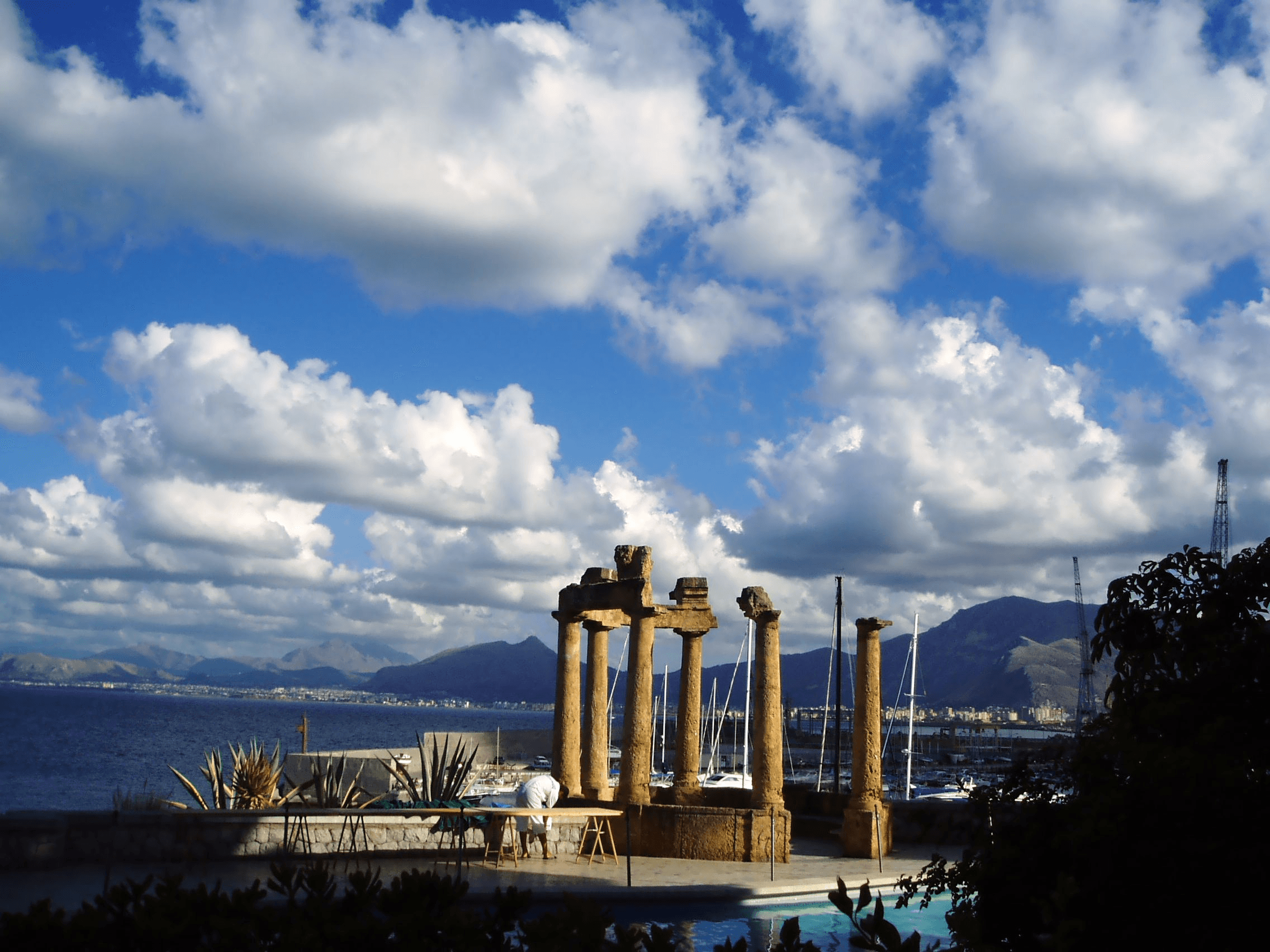
Villa Igiea
Ernesto Basile, a fin-de-siècle architect, created the Villa, which is an Art Nouveau fantasy with a model of brilliant elegance inside and a castle-like outside with turrets, towers, and crenellations. While Art Nouveau forms and themes are highlighted in the all-white corridors without taking centre stage, fabrics, plants, and other items in the restaurant—which opens directly onto a magnificent terrace overlooking the sea—maintain an indoor-outdoor feeling.
The gardens offer a breathtaking sight, with tamarisk, bananas, hibiscus, pines, and palms. Sleek pathways surrounded by fragrant plumbago, box, and jasmine hedges are ideal for elegant strolls following dinner, and colonial-style rattan loungers invite lazy days, or far niente as the Italians say.
Ernesto Basile, a fin-de-siècle architect, created the Villa, which is an Art Nouveau fantasy with a model of brilliant elegance inside and a castle-like outside with turrets, towers, and crenellations.
While Art Nouveau forms and themes are highlighted in the all-white corridors without taking centre stage, fabrics, plants, and other items in the restaurant—which opens directly onto a magnificent terrace overlooking the sea—maintain an indoor-outdoor feeling.
The gardens offer a breathtaking sight, with tamarisk, bananas, hibiscus, pines, and palms. Sleek pathways surrounded by fragrant plumbago, box, and jasmine hedges are ideal for elegant strolls following dinner, and colonial-style rattan loungers invite lazy days, or far niente as the Italians say.
The staff is almost perfect; they are considerate, observant, amiable, sympathetic, and have a talent for making everyone feel comfortable. The majority are locals who have a strong affinity for Palermo and the hotel, and the concierge desk is incredibly knowledgeable.
The Irene Forte spa offers restorative treatments that combine hot and cold volcanic rocks with organic skincare products derived from fruit, almonds, olives, and pistacchios from Sicily. Together with tennis courts and a private dock, there's a kidney-shaped pool. The hotel offers a tempting menu of day tours and adventures that may be reserved on any of its various boats.
With 72 rooms and 28 suites ranging from cosy Classics to opulent Forte Suites, Villa Igiea is a listed property. There are eleven distinct categories of rooms, each with a different size, perspective, and balcony or patio availability.
Every apartment in a structure like this has a distinct atmosphere, whether it's the vast sophistication of the Donna Franca suite, the easygoing vibe of a ground-floor suite with a private terrace, or the romance of a room in the tower. Bespoke services such as packing, unpacking, and ironing are included in a lot of suites, along with excellent wines and airport transportation upon arrival.
Together with the Igiea Terrazza bar (which boasts an excellent, sophisticated and distinctive drink menu), there are two dining options: the Florio and the more laid-back Alietta beside the pool. Breakfast is served at the Florio and consists of a delicious, constantly restocked buffet with a wide variety of savoury and sweet dishes, including several regional delicacies.
Hot food is prepared to order; my omelette with ricotta, mint, and courgettes was perfect. Both eateries place a strong emphasis on using excellent main ingredients in simple recipes. One such dish is the grouper, which is served raw and is unforgettable. It is accompanied by tiny pops of candied orange and chopped sun-dried tomatoes, capers, olives, and pistachios.
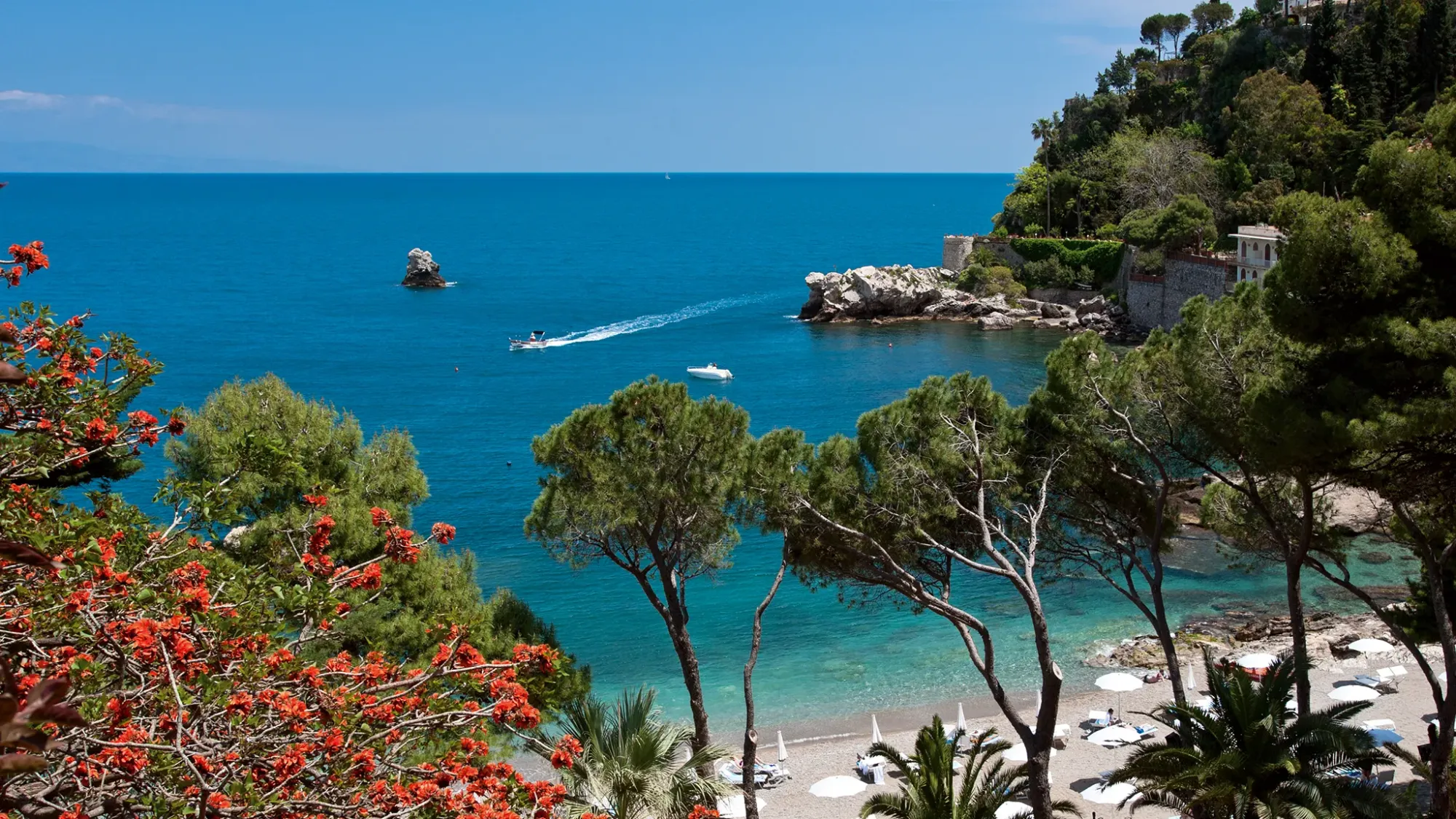
Belmond Villa Sant'Andrea
Belmond Villa Sant'Andrea
The hotel is located on a gorgeous pale sand beach dominated by a rugged promontory, which it shares with a few other hotels. Although it is accessible from a busy coastal road, it is located well below the road and has no traffic noise.
The hotel provides a free hourly shuttle to its sister hotel, the Timeo, in Taormina, making Sant'Andrea an excellent alternative for anyone looking to combine beach time with sightseeing, shopping, and dining in town.
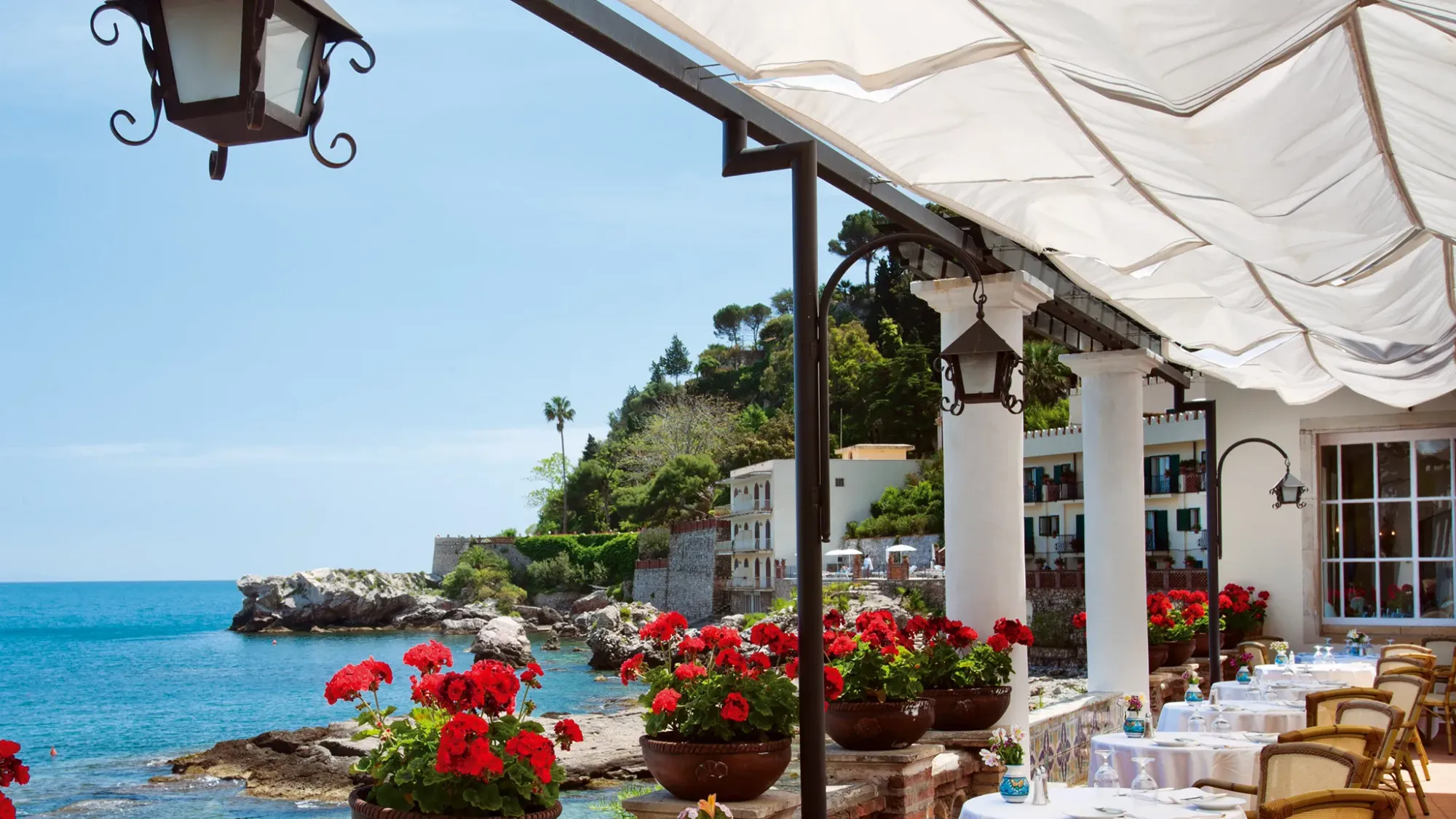
Belmond Villa Sant'Andrea
Mount Etna, the magnificent Alcantara gorge, the towns of Savoca and Forza d'Agro, where The Godfather was filmed, and Siracusa, with its islanded mediaeval core, are all nearby and easily accessible by day trip.
Sant'Andrea exudes old-fashioned class and style while without feeling stuffy or out of date. Despite its size (71 rooms), the hotel offers an intimate and personal vibe, reminiscent of an English country house by the Sicilian sea.
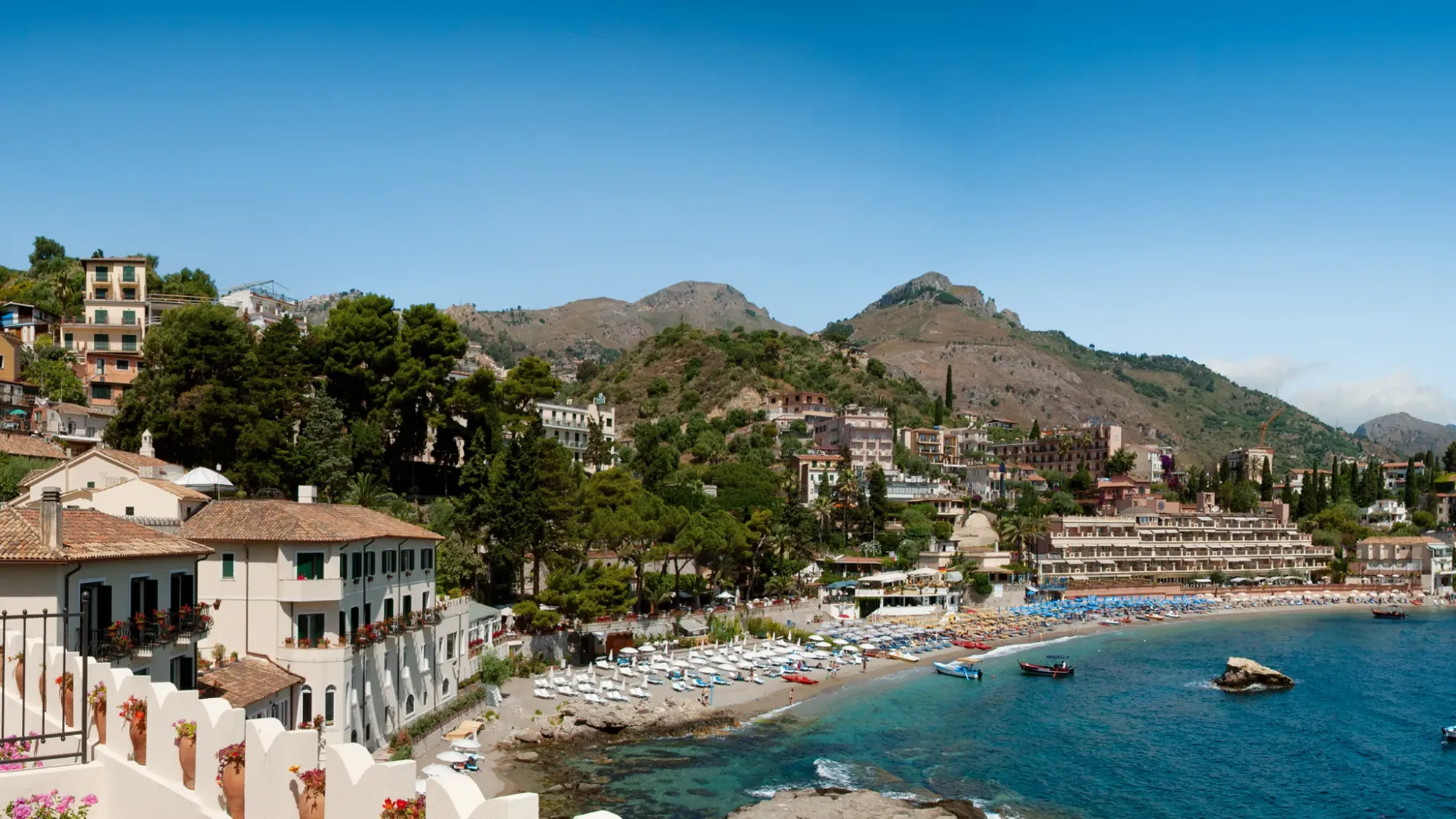
Belmond Villa Sant'Andrea
The hotel's core is the original 1919 villa, with opulent - but never ostentatious - marble floors and staircases, while Baroque paintings and family heirlooms scattered throughout the light airy lounge, reception hall and bar serve as conversation starters rather than recreating a stately home atmosphere.
Ortigia's glorious but faint scents of amber, citrus blossom, and prickly pear along the corridors complete the experience.
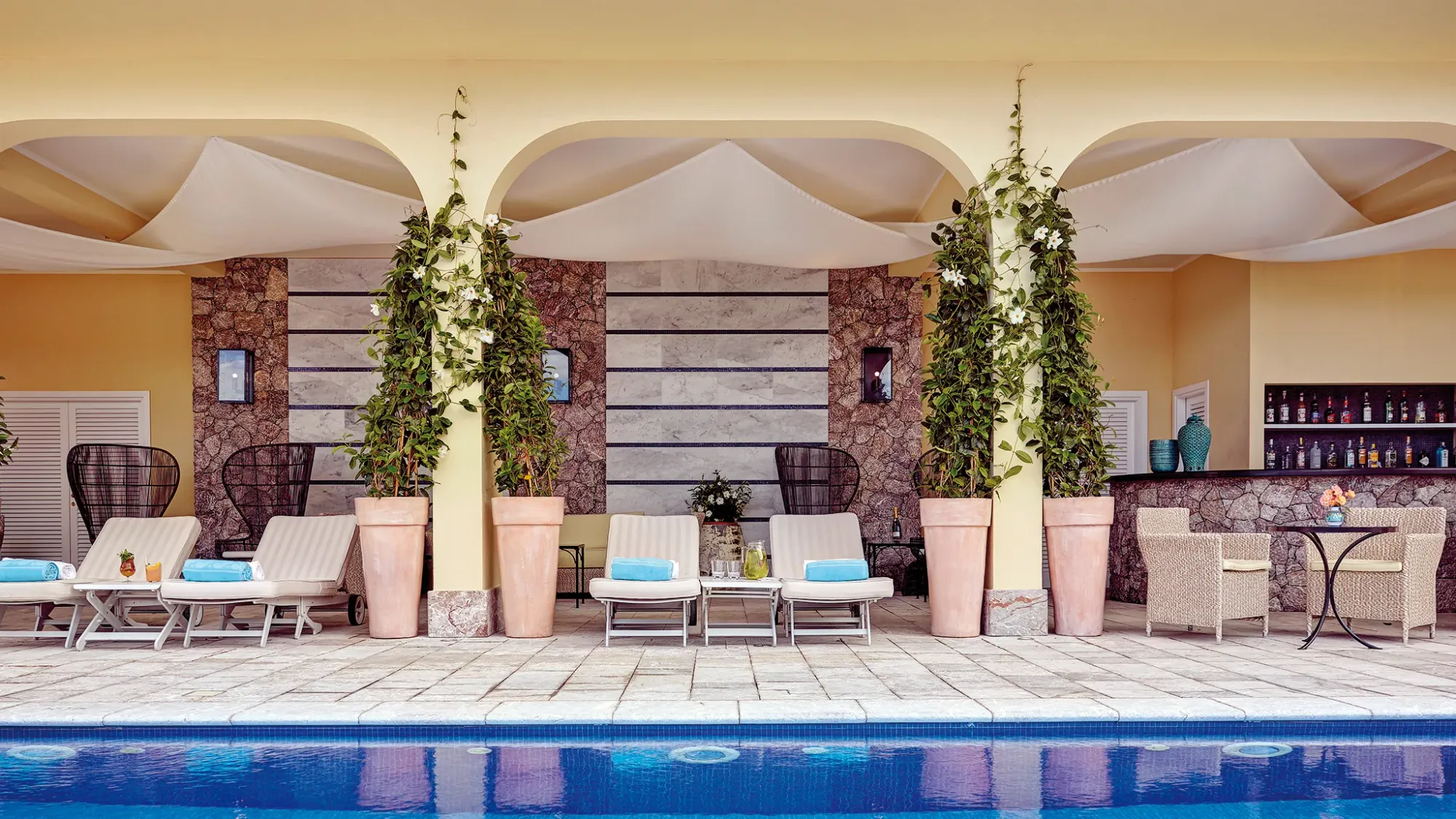
Belmond Villa Sant'Andrea
From the head waiter and sommelier to the beach sweepers, gardeners, and chambermaids, every member of staff was alert, efficient, kind, and inviting; there is a sense that the crew is proud of their property. Restaurant workers accurately identified which visitors wanted to converse and which preferred formality.
There is a small heated outdoor swimming pool with loungers and bar service, as well as bar service on the neatly groomed beach. A little playground for children is nestled among the grounds.
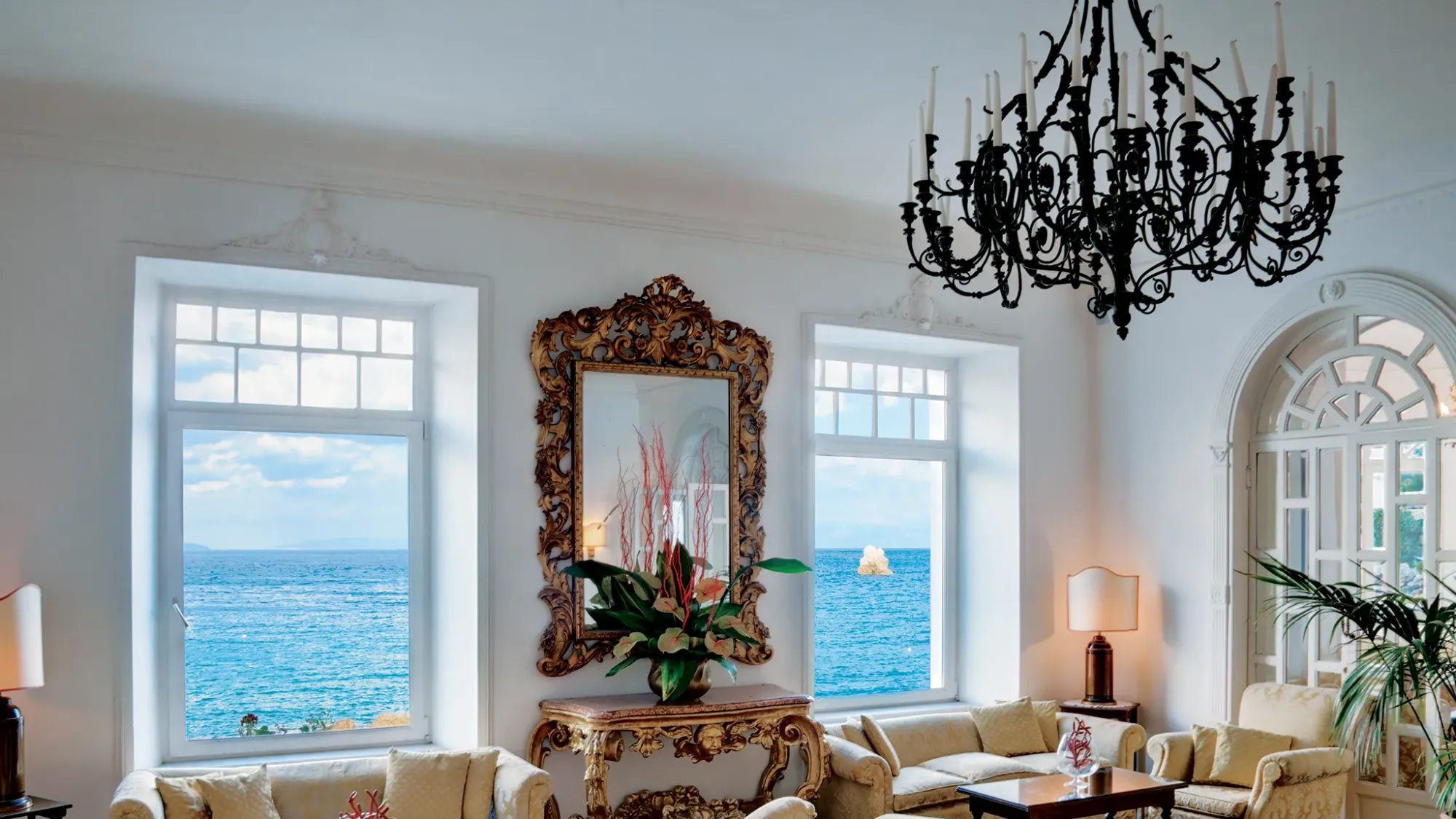
Belmond Villa Sant'Andrea
There is a spa on-site, complete with sauna, Turkish bath, and treatment rooms, and guests can also use the larger spa facilities of the Grand Hotel Timeo.
All guests receive a complimentary boat excursion, and fantastic literary tours of Taormina may be arranged on a traditional three-wheeler Piaggio Ape.
Imagine classic Italian elegance in subtle neutral tones. The majority of rooms have balconies or terraces that overlook the bay, while a few enjoy views of the subtropical gardens.
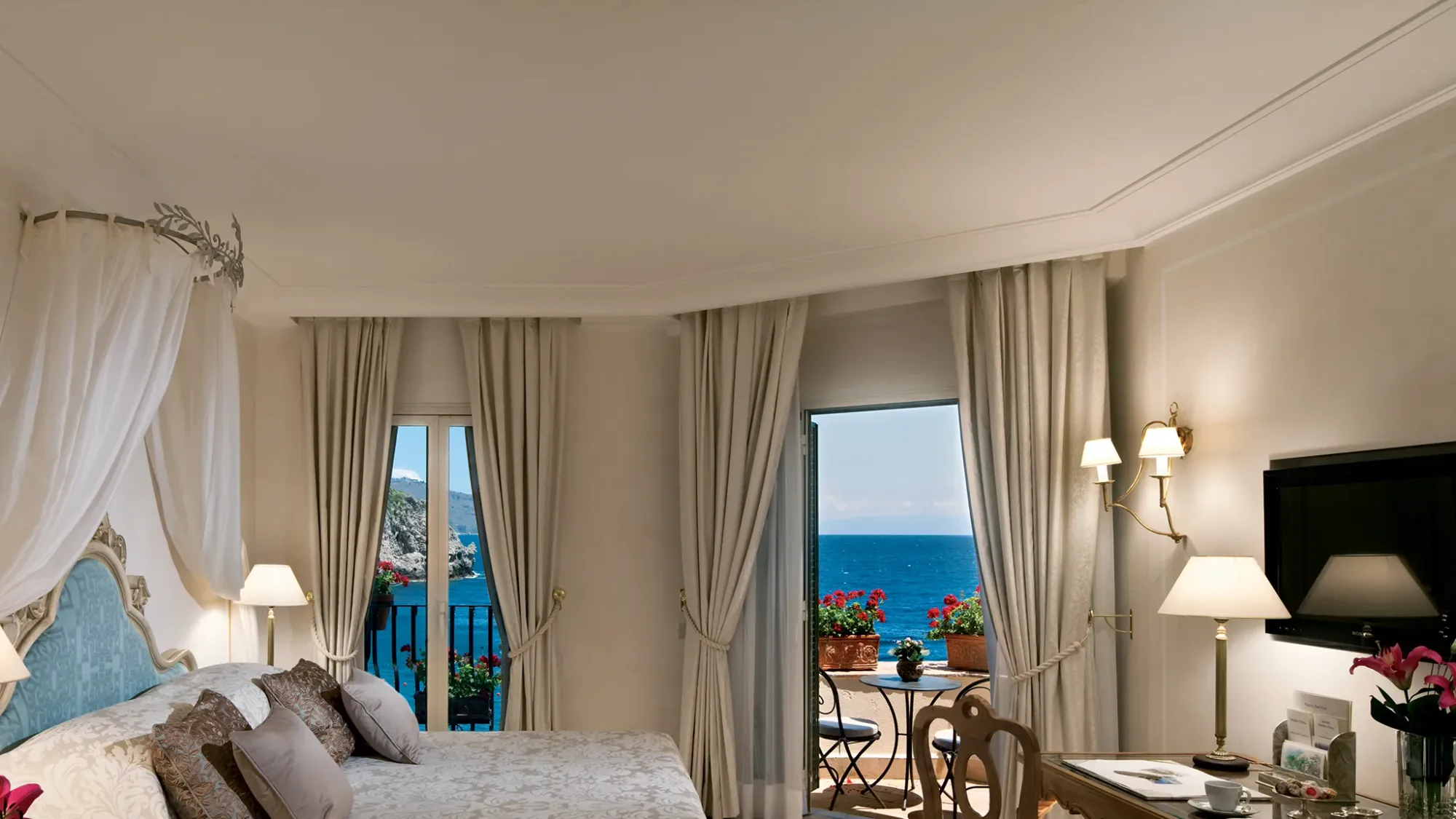
Belmond Villa Sant'Andrea
The most recent additions are three lovely Junior suites, each softly fragrant with Ortigia's room scents: Neroli (bitter orange), Zagara (orange blossom), and Gelsomino (jasmine).
Krups coffee machines, Alessi kettles, and loose tea caddies offer sophistication. Beautiful bathrooms including Sicilian ceramics, brass fittings, and copper baths.
In fine weather, dinner and breakfast are served on a terrace facing the beach; on cooler days, the dining room lacks character.
Breakfast is a substantial and well produced buffet, as well as a tantalising selection of à la carte alternatives. The food for lunch and supper is Sicilian with some deft and innovative tweaks and a well-assured layering of tastes; try the melted goat cheese with roast artichoke, wild fennel, and a sauce of blended fava beans and peas.
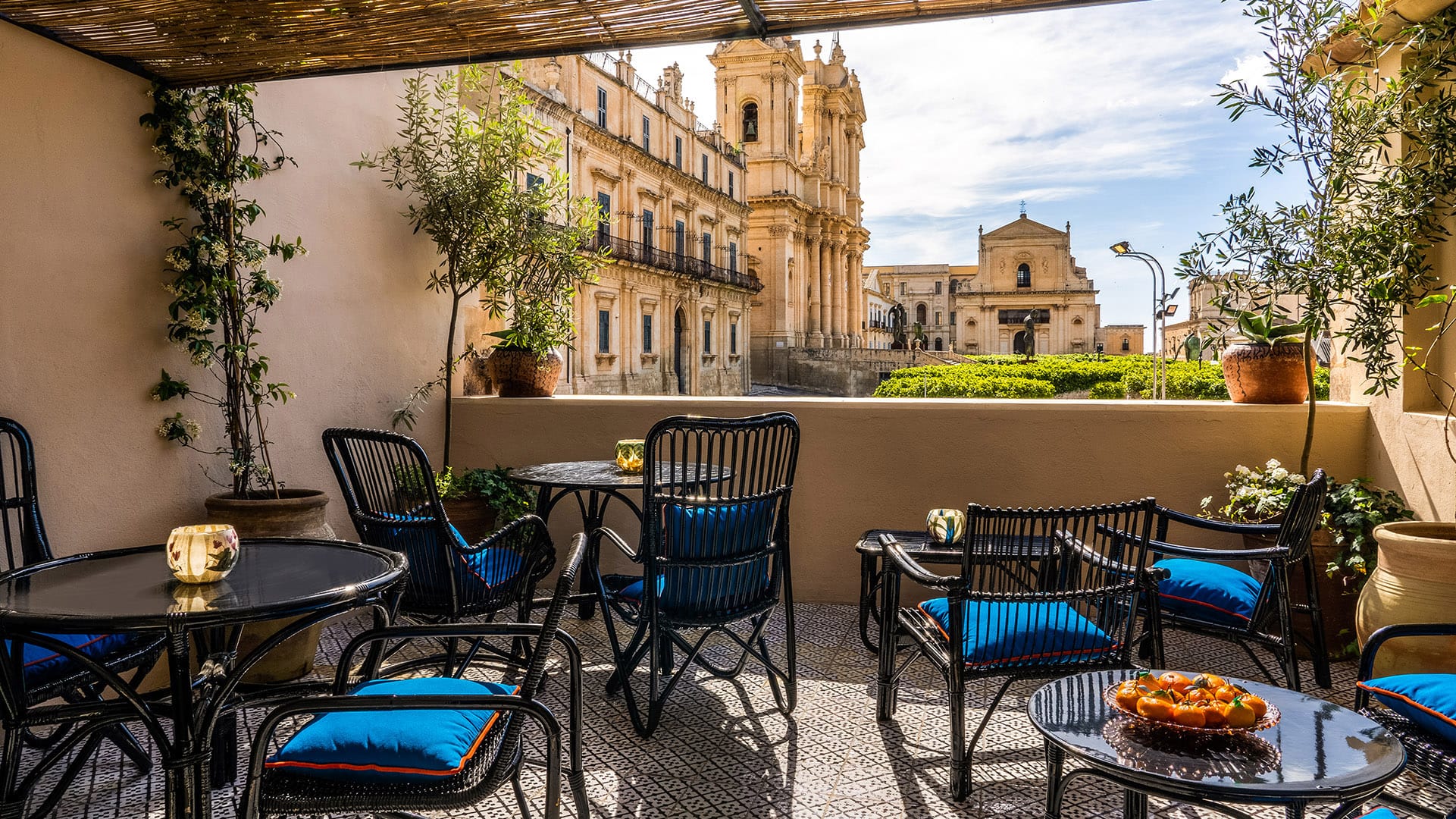
Q92
Q92
The views of Noto's Duomo and San Carlo's elaborate cupola are spectacular, yet despite the hotel's location on the busy main Corso, double-glazing eliminates street noise. All of the town's attractions, shops, pubs, and restaurants are within easy walking distance, and there is free parking on the plaza outside.
The ruins of Noto Antica (with a magnificent trek down the canyon of Cava Carasello), the Roman villa of Tellaro (with a pair of splendid mosaics of wild animals), and the beaches and salt-lagoons of the Vendicari natural reserve are all less than 30 minutes distant by car. Siracusa, Ragusa, Modica, and Scicli are a little further away but still fairly accessible for day vacations.
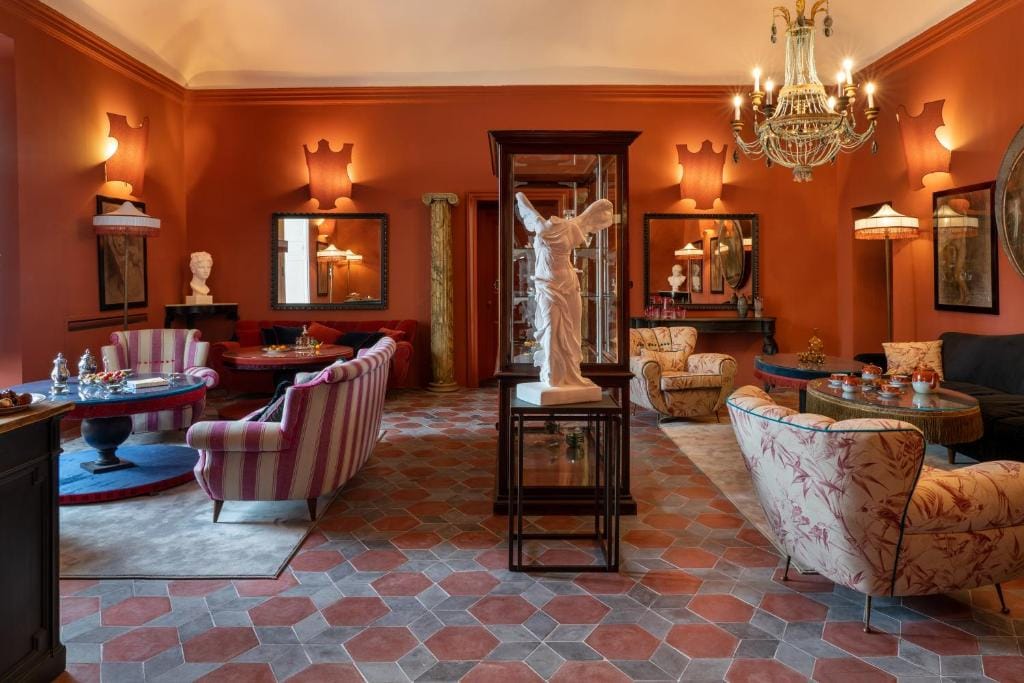
Q92
An beautiful apartment designed to be aesthetically pleasing, with 'shared spaces' that feel like rooms in a private home, including the elegant reception lounge. The walls are a deep Pompeiian red, a tribute to the Romans' favoured wall colour as well as the traditional grey, cream, and oxblood encaustic tiles retrieved from the Aeolian islands and installed throughout the hotel.
The salone, which opens onto a terrace overlooking the Duomo, is the hotel's heart, with slate-blue velvet drapes lined with tangerine silk (very Michelangelo), linen-upholstered sofas, a Venetian glass chandelier, a beautifully lit cabinet of glassware, and, on the walls, a series of 19th-century nudes, as well as prints and casts of Classical sculpture.
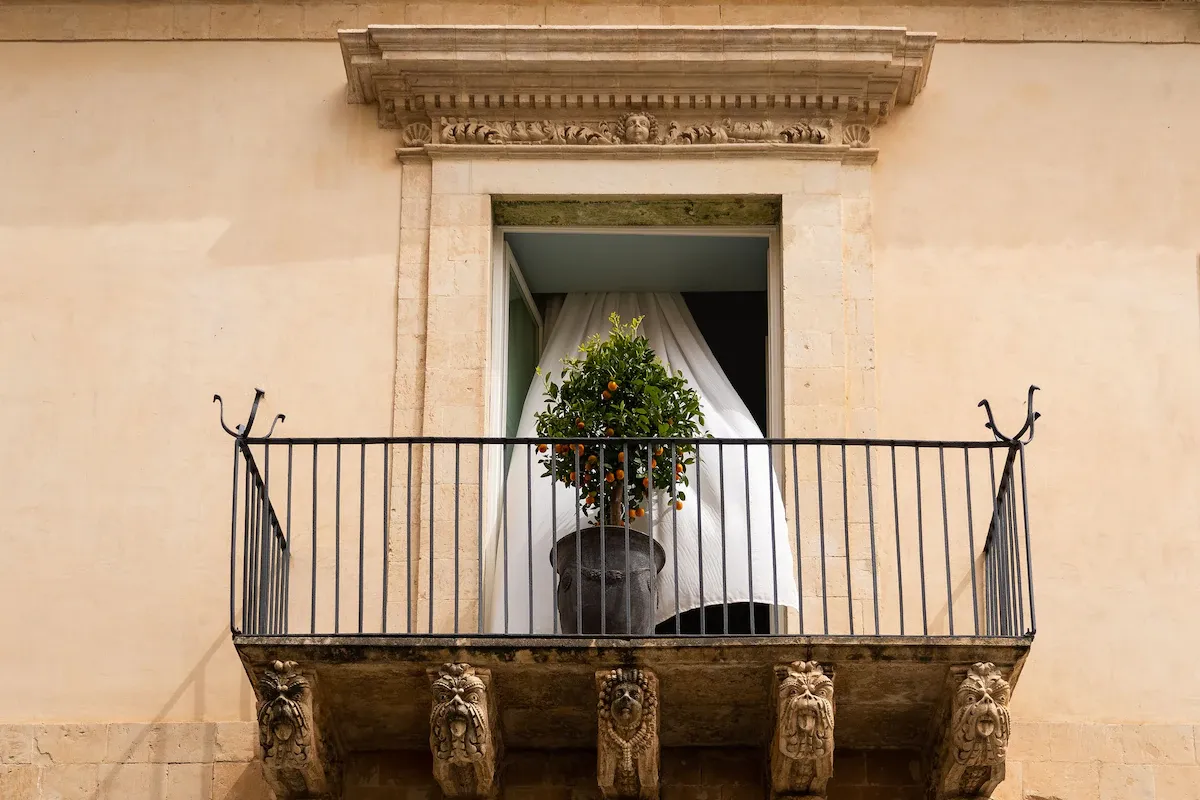
Q92
Coffee tables are scattered with art books, all of which are related to the inspiration for the décor and are ideal for perusing while sipping a cocktail.
A few steps above is the breakfast room, which features another patio, an eye-catching collection of cranberry glass, and tabletops adorned with Classical equestrian images. Downstairs, a charming tiny room furnished in a botanical motif overlooks a small courtyard garden with a plunge pool and honesty bar.
Friendly workers behave like hosts rather than employees, exuding joy and excitement, putting everyone at rest. All are informed about the area and can recommend restaurants and day trips, organise cooking lessons and wine tastings, and even reserve a sunbed at one of the lidos, if that's your thing.
There are just nine rooms, each different, ranging from spacious doubles to three huge master suites – all of these have balconies; one has an original Baroque frescoed ceiling.
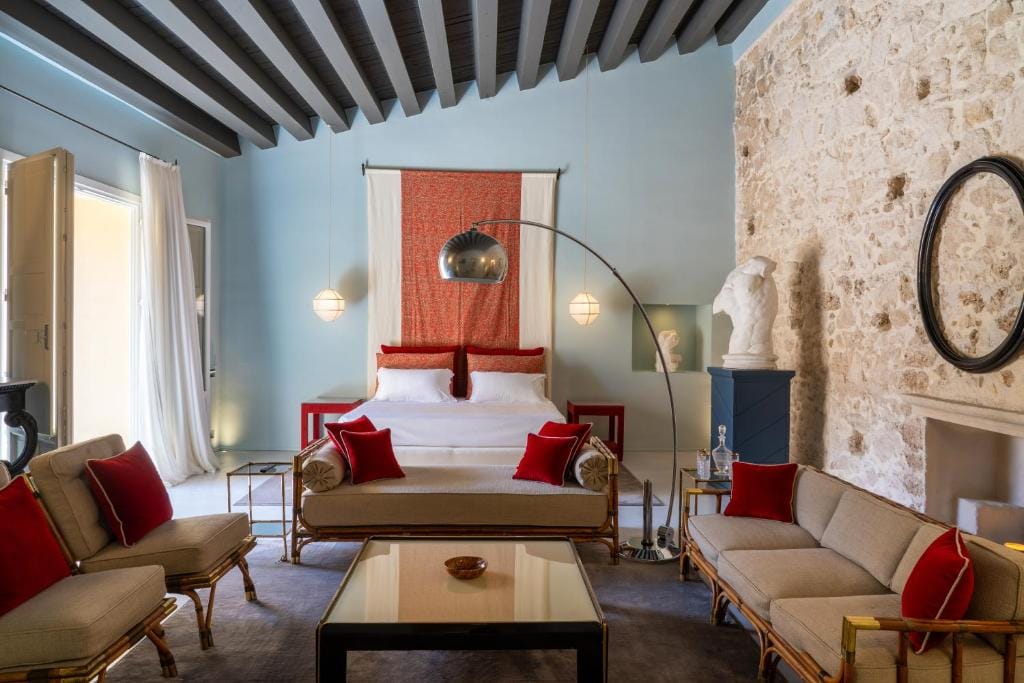
Q92
As the hotel was full when we stayed, we only saw the Master Suite we slept in, which had China blue walls, a black floor, trompe l’oeil medallions, and a freestanding cast of a Classical torso, two balconies, a vast black velvet sofa and armchairs, and two bathrooms, with beautiful wallpaper. Toiletries are by Etro.
Breakfast is beautifully presented in the glass cabinet, with guests helping themselves to small bowls of fresh fruit, an assortment of tarts (crostate) filled with jam, ricotta, chocolate, and pistachio cream, as well as miniature cornetti. Savoury options include tomato salad, gammon and salami, a variety of local cheeses and scrambled egg and bacon.
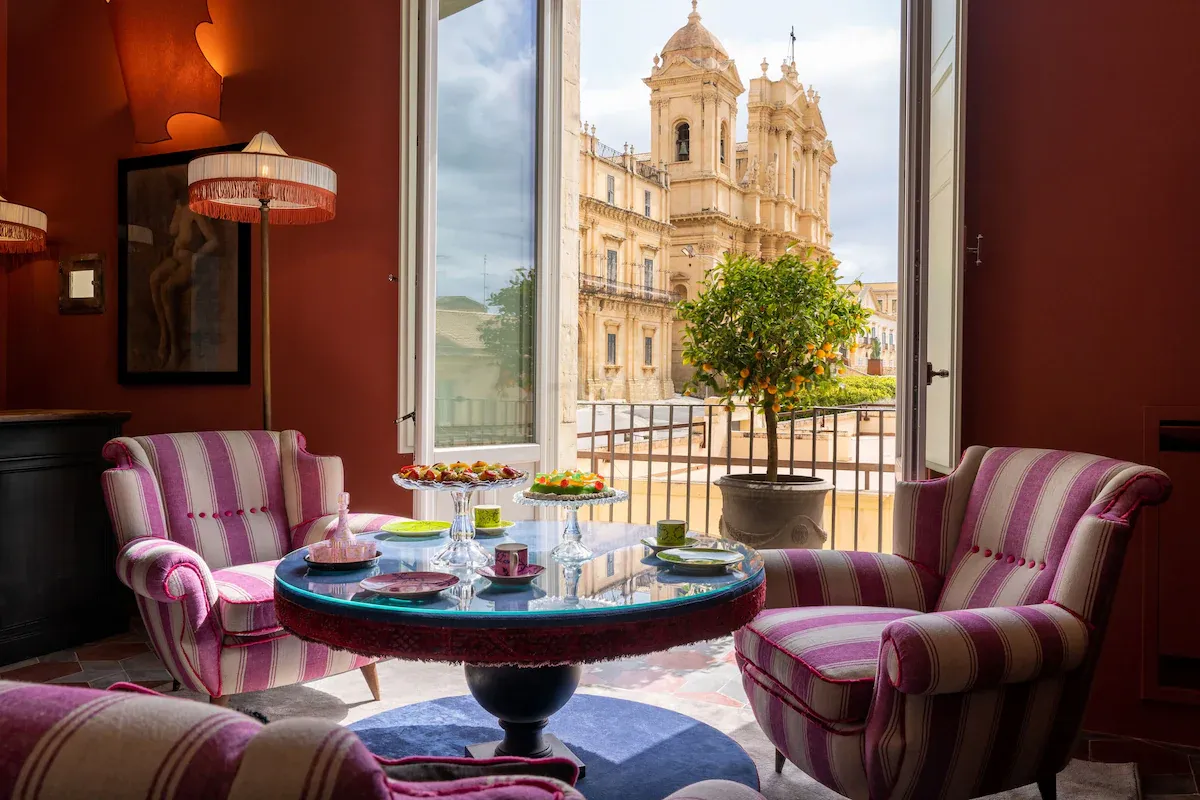
Q92
Throughout the day, tea and coffee are offered, as well as some excellent cocktails and a choice of local liqueurs, including Elorì with bitter orange, wild thyme, and wild asparagus. Although there is no restaurant, Noto does have several excellent dining options. Il Crocifisso, where Marco Baglieri prepares complex and delectable meals influenced by Sicilian cuisine and produce, is not to be missed.
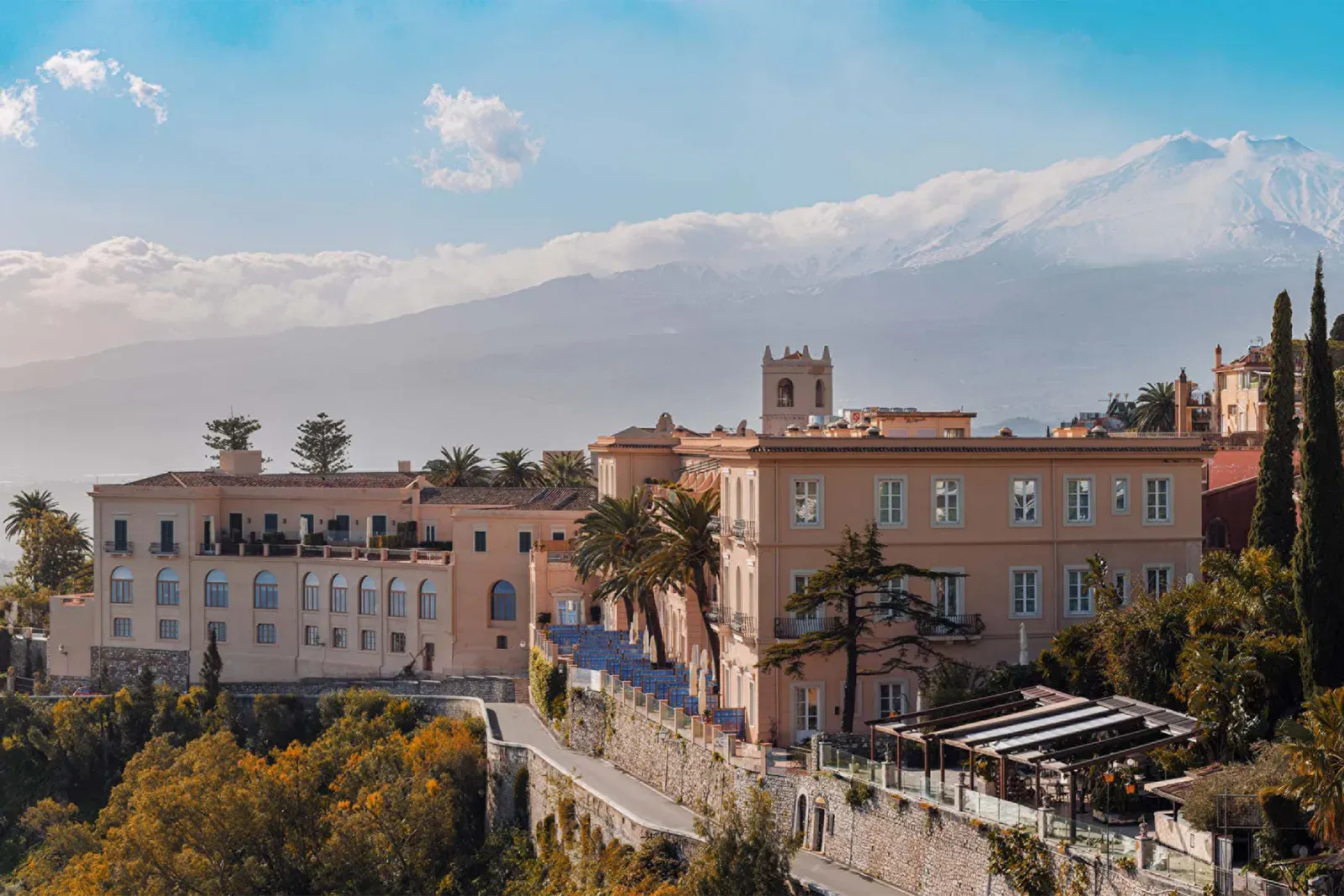
San Domenico Palace
San Domenico Palace
The hotel is centrally placed yet set back from Taormina's lovely tiny streets, where pottery shops compete with concept stores. It is only minutes away from the town's Belvedere viewpoint and the Piazza Duomo, and around 15 minutes' walk from the Greek theatre.
While the façade of the hotel faces the town, stroll inside the historic walls to uncover the lush, bougainvillea-clad gardens that lead down to the cliff's edge and view the sea. An outstanding location.
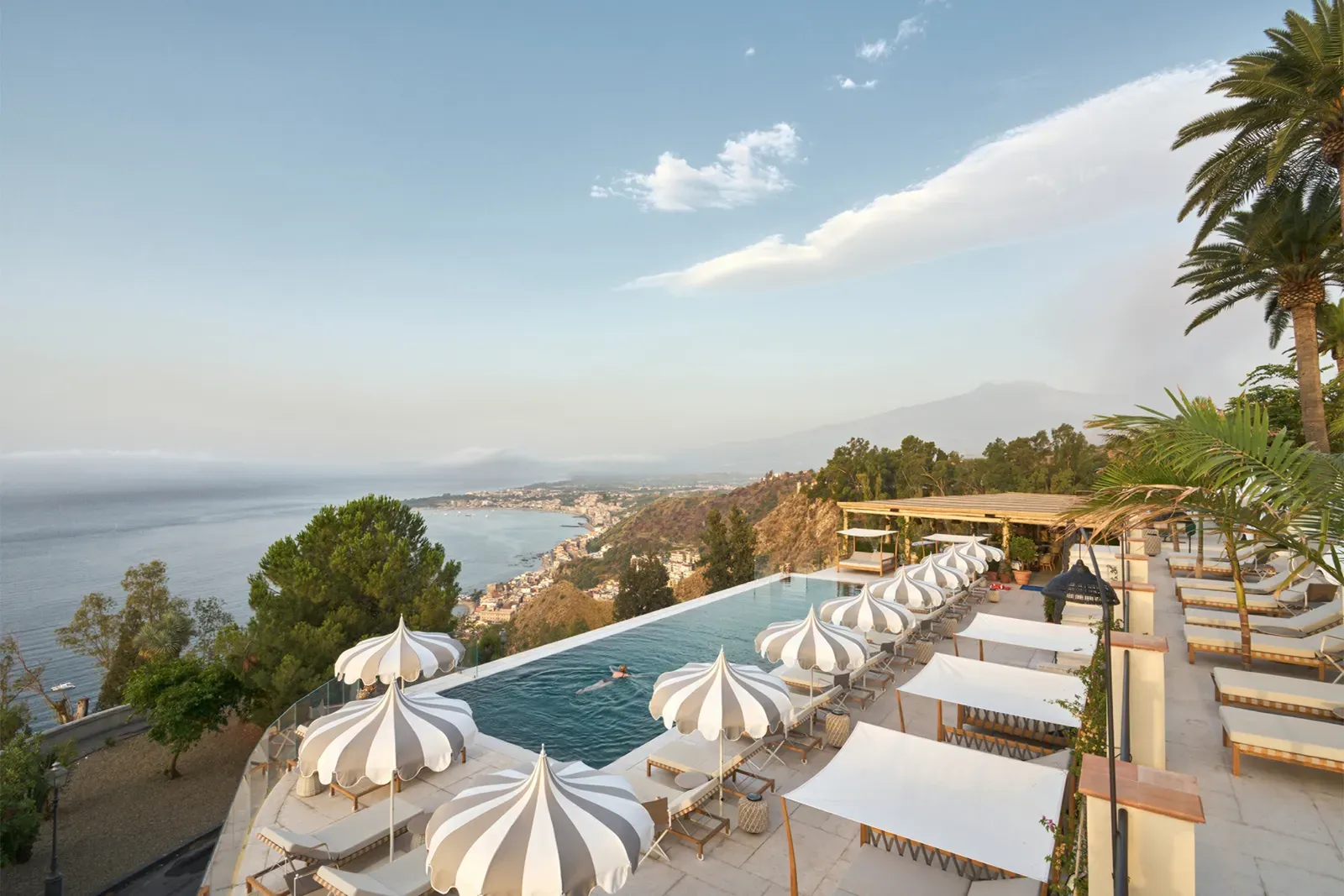
San Domenico Palace
Although Four Seasons Hotels and Resorts added a healthy dose of 21st-century luxury when they took over San Domenico, redecorating the rooms in the 19th-century wing and adding private plunge pools to some of the terraces, they were careful to preserve the many impressive historical elements, from the statue-filled courtyards to the stone doorway you enter through.
Sip a beverage at the Grand Cloister, Bar & Chiostro and feel the weight of history. Peek into one of the monastery cells, the smallest of the bedrooms, and you can envision the monks' lives, fragrant with the lemon trees and lavender they planted, which are still flourishing today.
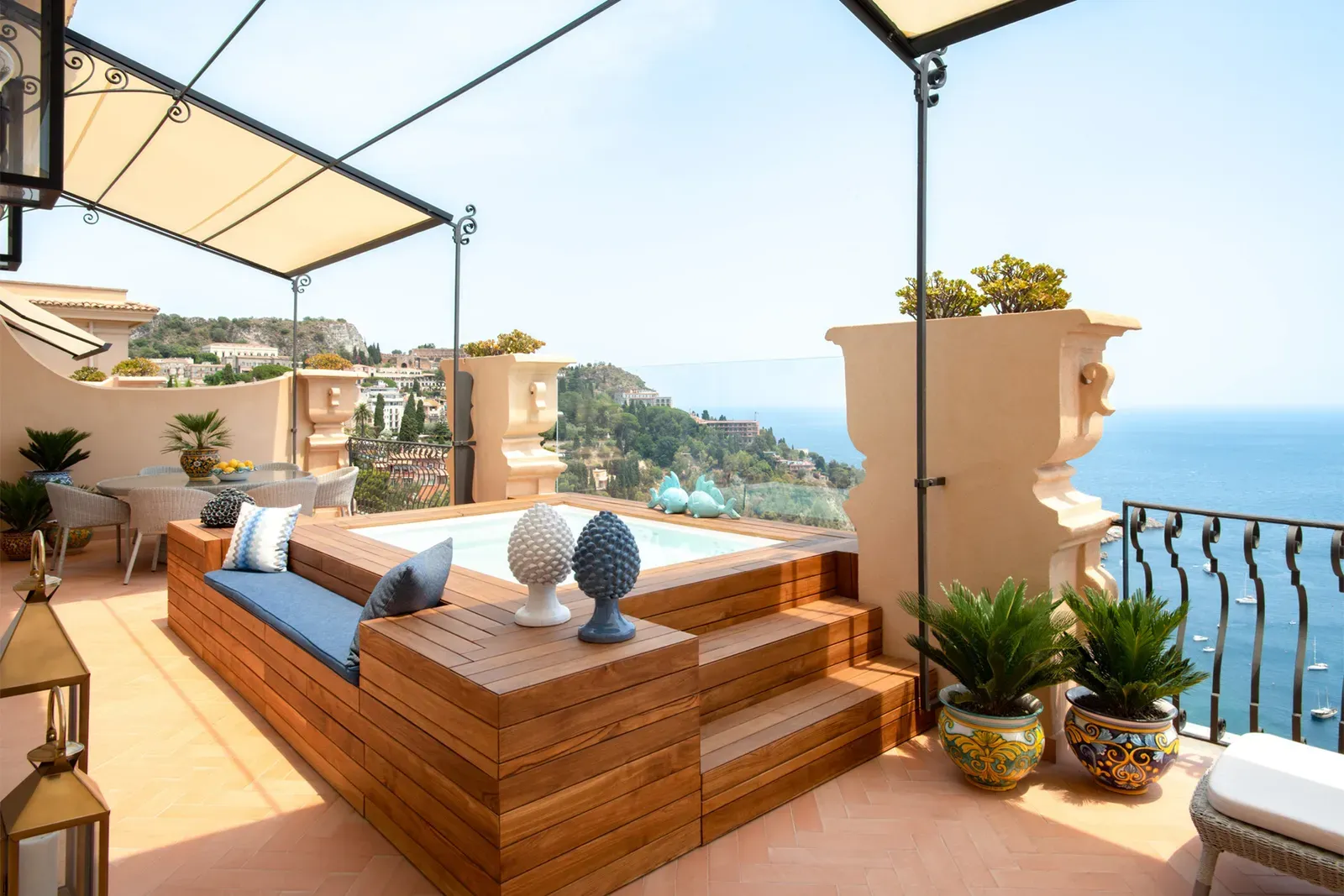
San Domenico Palace
The hotel's allure that drew Richard Burton and Elizabeth Taylor, Greta Garbo and Humphrey Bogart, and many other celebrities of their time endures, as does its connection to the screen, most recently as the backdrop for the Netflix series The White Lotus.
Service is always good in a Four Seasons hotel, and it is made even better in warm Sicily by the charming way it is presented. The facilities are outstanding, from the planned activities like as a starlight safari on Mount Etna to the boats that can take you out to explore Taormina from the sea. There is a 21-meter infinity pool, one of the most gorgeous pools anywhere, a Botanica pop-up spa, and a well-equipped gym.
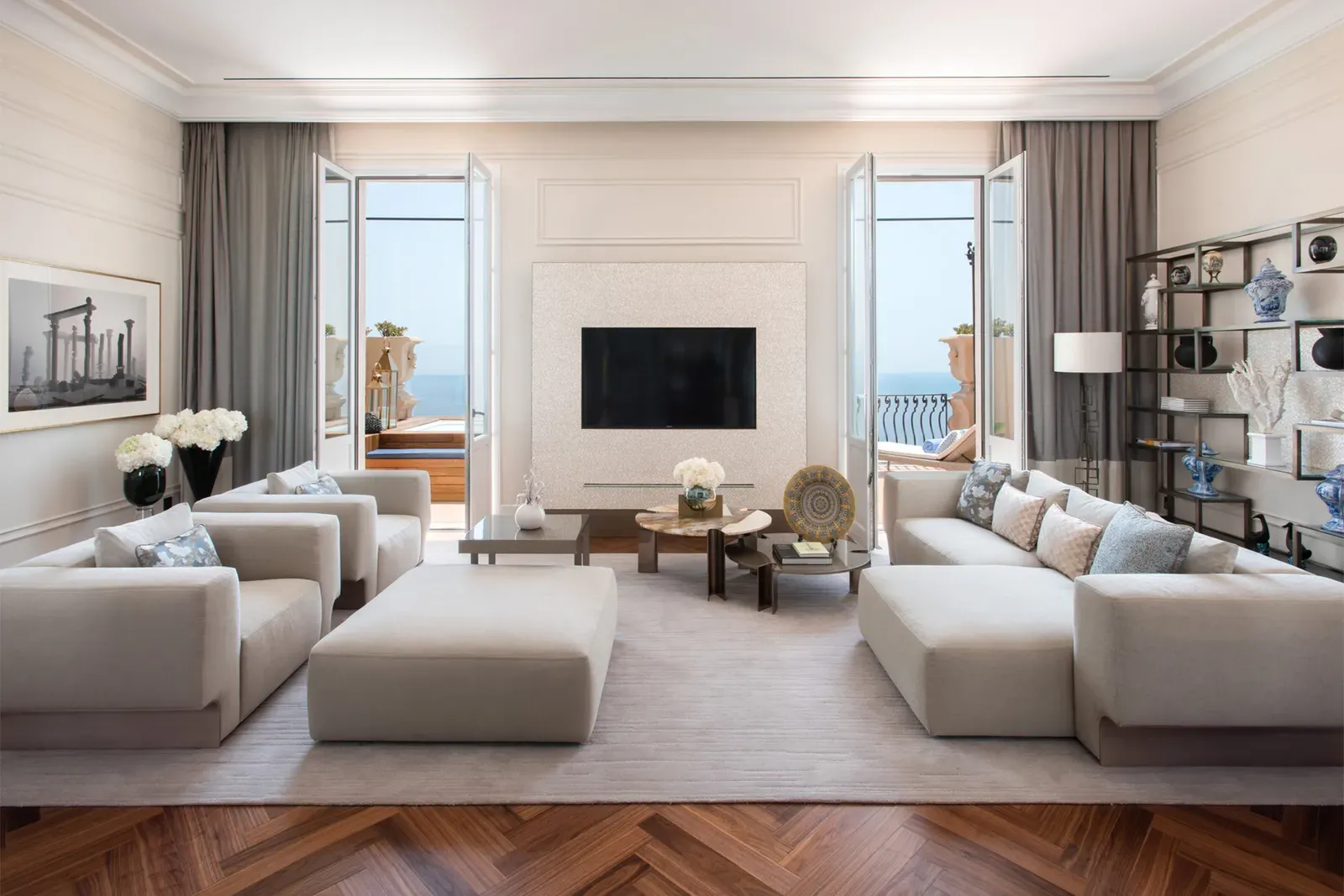
San Domenico Palace
Out of the 111 rooms and suites, the modest bedrooms in the historic wing that used to be the monks' cells provide an unrivalled feeling of place and ambience. A fresco of a saint hangs above each entry, with views of the magnificent gardens. The 19th-century wing, which was added when the building became a hotel, has had all of its rooms totally refurbished.
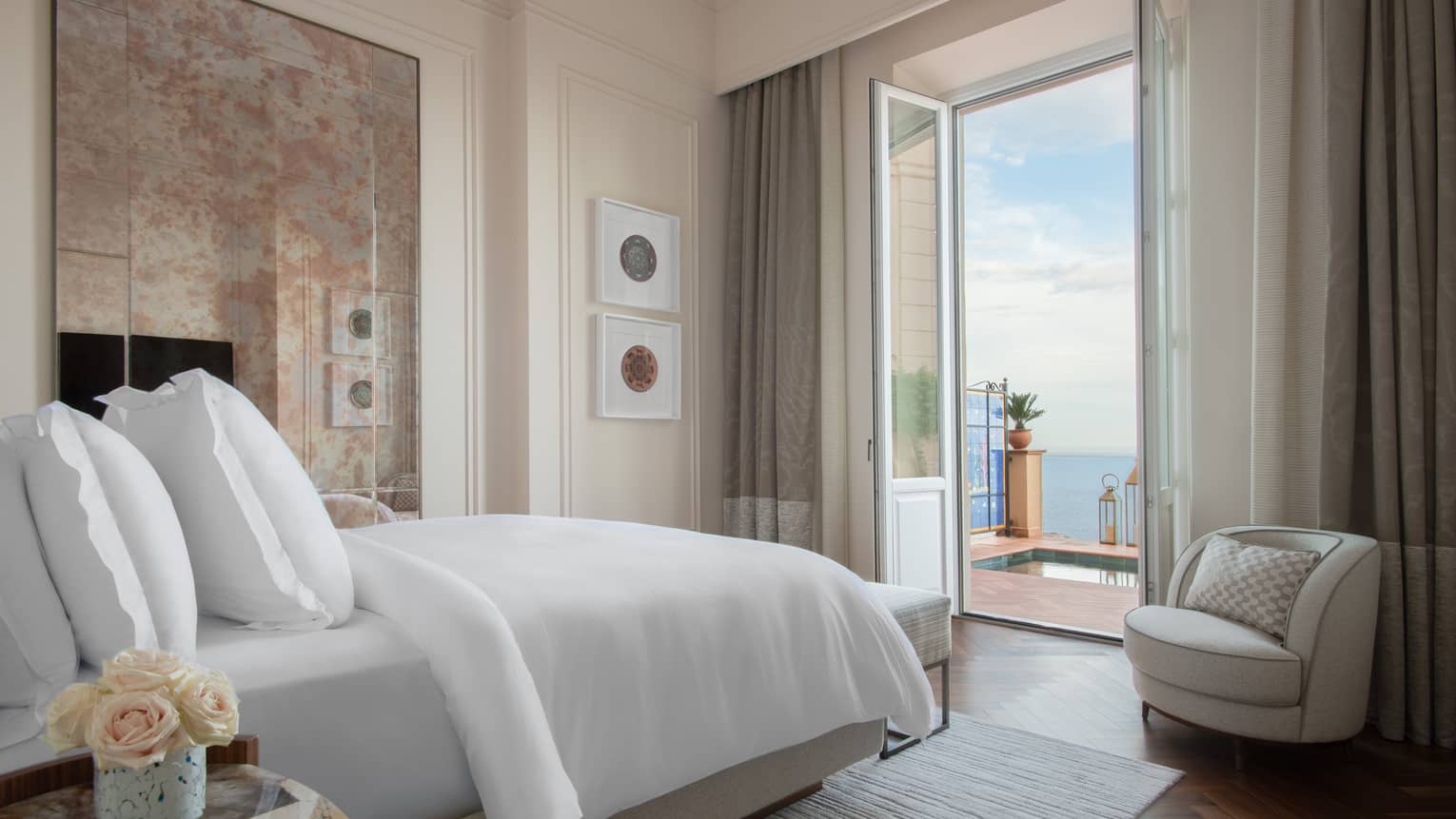
San Domenico Palace
They come in muted, neutral tones, with high ceilings and floor-to-ceiling windows that let in the dazzling blue sea. Many have terraces where you may enjoy breakfast with a view, and others have plunge pools inset.
Chef Massimo Mantarri is in charge of Michelin-starred Principe Cerami restaurant. Enjoy risotto with anchovies, fennel, and Bronte pistachios, or braised ox cheek with Sicilian vermouth, mashed potatoes, Etna juniper, and white truffles.
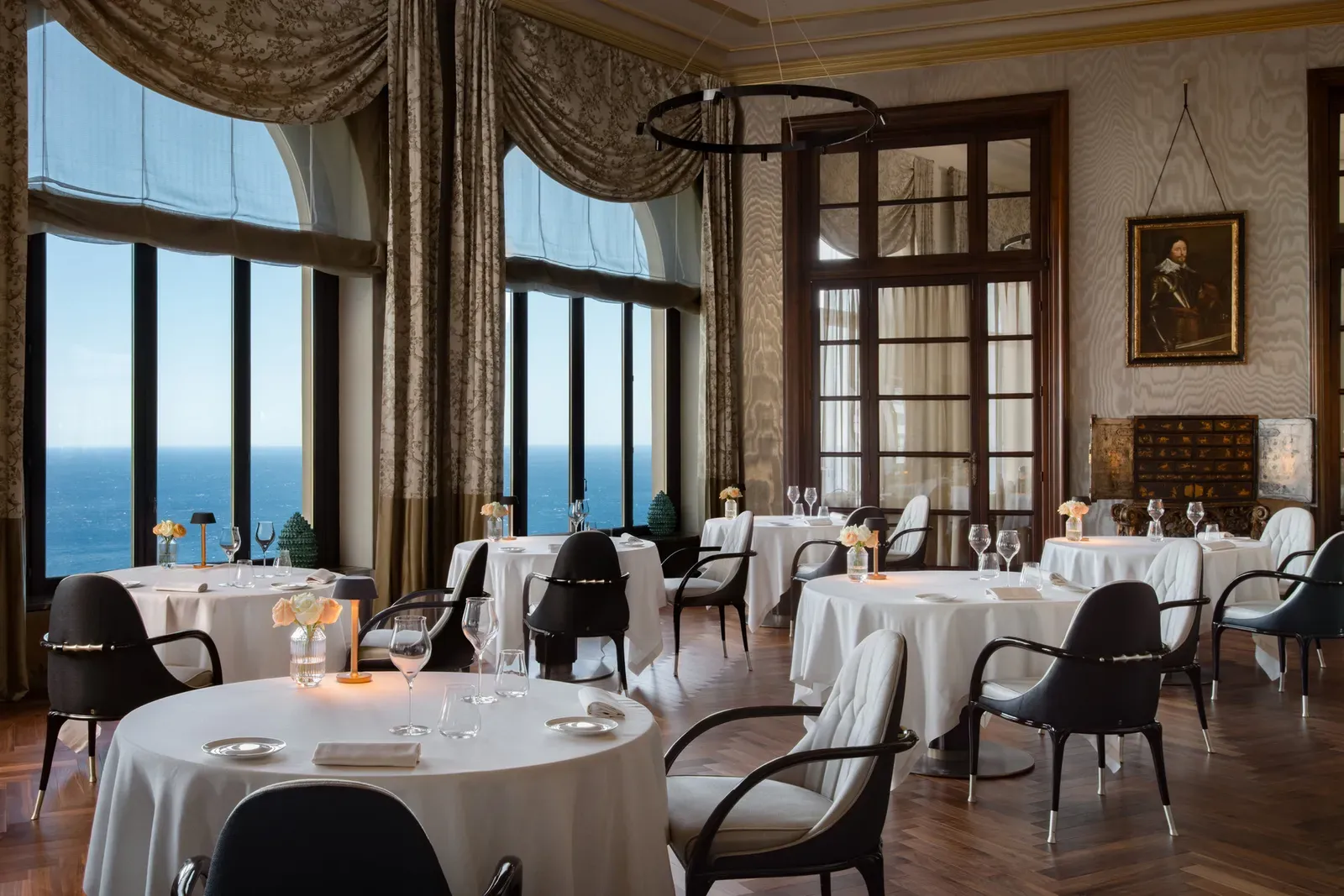
San Domenico Palace
For lunch, head to Anciovi, which overlooks the magnificent bay and serves Sicilian tuna tartare with avocado or linguine with lobster.
Breakfast is served on the terrace and in the main restaurant, with both buffet and à la carte options. Don't miss the classic cassata (ice cream cake), which moves around the dining room on its own trolley.
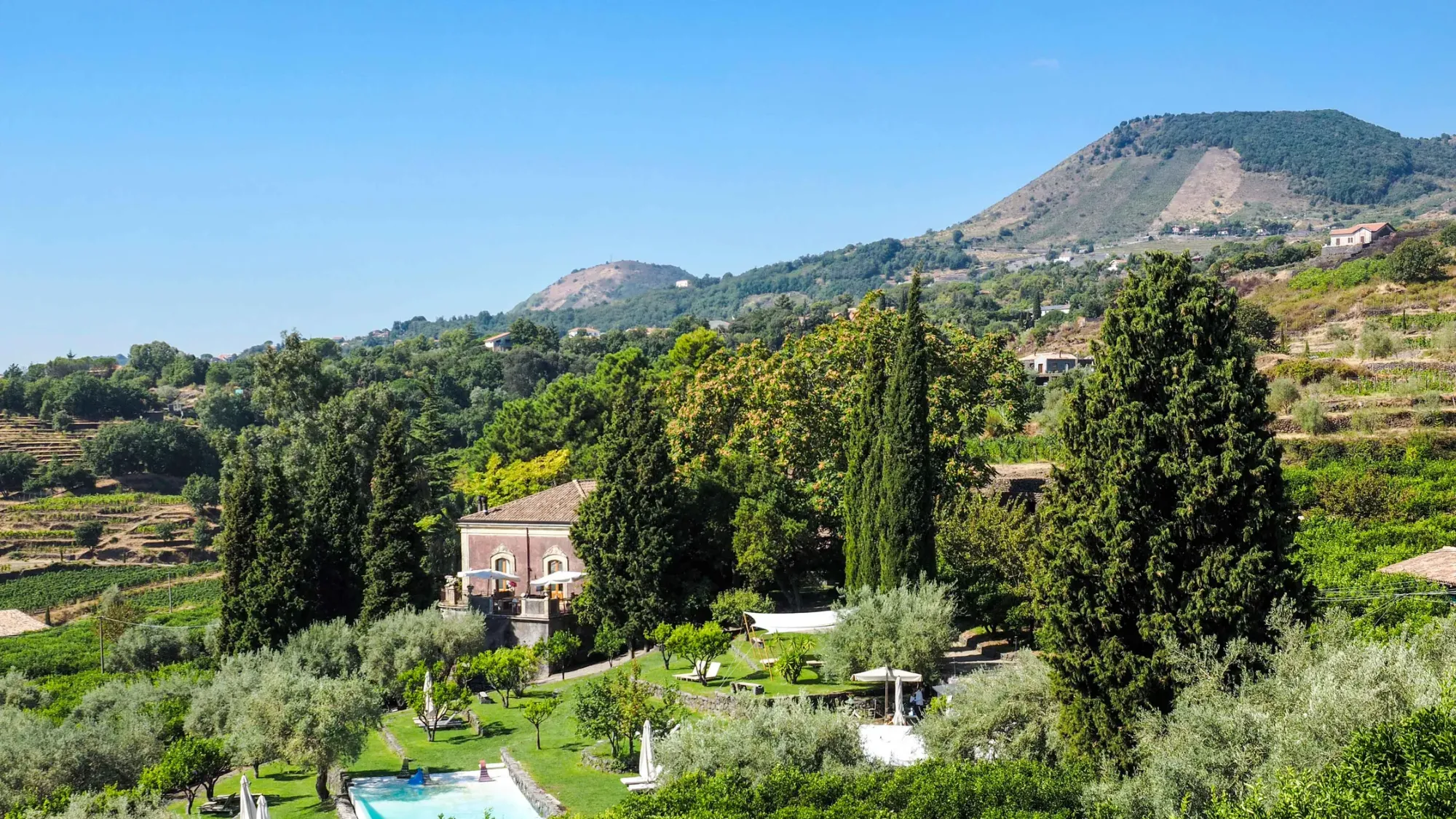
Monaci delle Terre Nere
Monaci delle Terre Nere
It's halfway between Taormina and Catania, high up on Etna's eastern flanks, where ancient bush-trained vines emerge from the black, lava-rich soil on dry stone terraces. It's well located for both beach days and guided walks through the Etna crater zone.
Sicily, the largest island in the Mediterranean, is a fascinating destination rich in history and natural beauty. It is no surprise that a lot of movies and TV shows (like white lotus) have been filmed on the island considering how breathtaking every corner of Sicily is.
With a complex tapestry of civilizations that includes ancient Greek temples, Roman ruins, and Norman castles, each one tells a tale about the island's diverse history.
Its dramatic coastline is studded with lovely beaches, while rocky mountains and fertile valleys provide a breathtaking backdrop for exploring. Sicilian cuisine is a gourmet treat that includes fresh fish, savoury pasta, and sweet cannolis. From the bustling streets of Palermo to the lovely towns of Taormina, the island is rich in experiences for all types of visitors.
Best Hotels in Sicily

Villa Igiea
Villa Igiea
A little village on the outskirts of Palermo, noted for its fresh winds and healing springs, surrounding the villa when it was erected by Sicilian business magnate Ignazio Florio and his socialite wife, Franca. All of that has changed, and the hotel now stands in a run-down suburb above a tiny harbour.
The village of Arenella, ten minutes' walk away, has an audacious charm all its own, but you come to this hotel to enjoy the opulence within. There is a free shuttle bus service to the centre on a regular basis for people who wish to explore Palermo.

Villa Igiea
Ernesto Basile, a fin-de-siècle architect, created the Villa, which is an Art Nouveau fantasy with a model of brilliant elegance inside and a castle-like outside with turrets, towers, and crenellations. While Art Nouveau forms and themes are highlighted in the all-white corridors without taking centre stage, fabrics, plants, and other items in the restaurant—which opens directly onto a magnificent terrace overlooking the sea—maintain an indoor-outdoor feeling.
The gardens offer a breathtaking sight, with tamarisk, bananas, hibiscus, pines, and palms. Sleek pathways surrounded by fragrant plumbago, box, and jasmine hedges are ideal for elegant strolls following dinner, and colonial-style rattan loungers invite lazy days, or far niente as the Italians say.
Ernesto Basile, a fin-de-siècle architect, created the Villa, which is an Art Nouveau fantasy with a model of brilliant elegance inside and a castle-like outside with turrets, towers, and crenellations.
While Art Nouveau forms and themes are highlighted in the all-white corridors without taking centre stage, fabrics, plants, and other items in the restaurant—which opens directly onto a magnificent terrace overlooking the sea—maintain an indoor-outdoor feeling.
The gardens offer a breathtaking sight, with tamarisk, bananas, hibiscus, pines, and palms. Sleek pathways surrounded by fragrant plumbago, box, and jasmine hedges are ideal for elegant strolls following dinner, and colonial-style rattan loungers invite lazy days, or far niente as the Italians say.
The staff is almost perfect; they are considerate, observant, amiable, sympathetic, and have a talent for making everyone feel comfortable. The majority are locals who have a strong affinity for Palermo and the hotel, and the concierge desk is incredibly knowledgeable.
The Irene Forte spa offers restorative treatments that combine hot and cold volcanic rocks with organic skincare products derived from fruit, almonds, olives, and pistacchios from Sicily. Together with tennis courts and a private dock, there's a kidney-shaped pool. The hotel offers a tempting menu of day tours and adventures that may be reserved on any of its various boats.
With 72 rooms and 28 suites ranging from cosy Classics to opulent Forte Suites, Villa Igiea is a listed property. There are eleven distinct categories of rooms, each with a different size, perspective, and balcony or patio availability.
Every apartment in a structure like this has a distinct atmosphere, whether it's the vast sophistication of the Donna Franca suite, the easygoing vibe of a ground-floor suite with a private terrace, or the romance of a room in the tower. Bespoke services such as packing, unpacking, and ironing are included in a lot of suites, along with excellent wines and airport transportation upon arrival.
Together with the Igiea Terrazza bar (which boasts an excellent, sophisticated and distinctive drink menu), there are two dining options: the Florio and the more laid-back Alietta beside the pool. Breakfast is served at the Florio and consists of a delicious, constantly restocked buffet with a wide variety of savoury and sweet dishes, including several regional delicacies.
Hot food is prepared to order; my omelette with ricotta, mint, and courgettes was perfect. Both eateries place a strong emphasis on using excellent main ingredients in simple recipes. One such dish is the grouper, which is served raw and is unforgettable. It is accompanied by tiny pops of candied orange and chopped sun-dried tomatoes, capers, olives, and pistachios.

Belmond Villa Sant'Andrea
Belmond Villa Sant'Andrea
The hotel is located on a gorgeous pale sand beach dominated by a rugged promontory, which it shares with a few other hotels. Although it is accessible from a busy coastal road, it is located well below the road and has no traffic noise.
The hotel provides a free hourly shuttle to its sister hotel, the Timeo, in Taormina, making Sant'Andrea an excellent alternative for anyone looking to combine beach time with sightseeing, shopping, and dining in town.

Belmond Villa Sant'Andrea
Mount Etna, the magnificent Alcantara gorge, the towns of Savoca and Forza d'Agro, where The Godfather was filmed, and Siracusa, with its islanded mediaeval core, are all nearby and easily accessible by day trip.
Sant'Andrea exudes old-fashioned class and style while without feeling stuffy or out of date. Despite its size (71 rooms), the hotel offers an intimate and personal vibe, reminiscent of an English country house by the Sicilian sea.

Belmond Villa Sant'Andrea
The hotel's core is the original 1919 villa, with opulent - but never ostentatious - marble floors and staircases, while Baroque paintings and family heirlooms scattered throughout the light airy lounge, reception hall and bar serve as conversation starters rather than recreating a stately home atmosphere.
Ortigia's glorious but faint scents of amber, citrus blossom, and prickly pear along the corridors complete the experience.

Belmond Villa Sant'Andrea
From the head waiter and sommelier to the beach sweepers, gardeners, and chambermaids, every member of staff was alert, efficient, kind, and inviting; there is a sense that the crew is proud of their property. Restaurant workers accurately identified which visitors wanted to converse and which preferred formality.
There is a small heated outdoor swimming pool with loungers and bar service, as well as bar service on the neatly groomed beach. A little playground for children is nestled among the grounds.

Belmond Villa Sant'Andrea
There is a spa on-site, complete with sauna, Turkish bath, and treatment rooms, and guests can also use the larger spa facilities of the Grand Hotel Timeo.
All guests receive a complimentary boat excursion, and fantastic literary tours of Taormina may be arranged on a traditional three-wheeler Piaggio Ape.
Imagine classic Italian elegance in subtle neutral tones. The majority of rooms have balconies or terraces that overlook the bay, while a few enjoy views of the subtropical gardens.

Belmond Villa Sant'Andrea
The most recent additions are three lovely Junior suites, each softly fragrant with Ortigia's room scents: Neroli (bitter orange), Zagara (orange blossom), and Gelsomino (jasmine).
Krups coffee machines, Alessi kettles, and loose tea caddies offer sophistication. Beautiful bathrooms including Sicilian ceramics, brass fittings, and copper baths.
In fine weather, dinner and breakfast are served on a terrace facing the beach; on cooler days, the dining room lacks character.
Breakfast is a substantial and well produced buffet, as well as a tantalising selection of à la carte alternatives. The food for lunch and supper is Sicilian with some deft and innovative tweaks and a well-assured layering of tastes; try the melted goat cheese with roast artichoke, wild fennel, and a sauce of blended fava beans and peas.

Q92
Q92
The views of Noto's Duomo and San Carlo's elaborate cupola are spectacular, yet despite the hotel's location on the busy main Corso, double-glazing eliminates street noise. All of the town's attractions, shops, pubs, and restaurants are within easy walking distance, and there is free parking on the plaza outside.
The ruins of Noto Antica (with a magnificent trek down the canyon of Cava Carasello), the Roman villa of Tellaro (with a pair of splendid mosaics of wild animals), and the beaches and salt-lagoons of the Vendicari natural reserve are all less than 30 minutes distant by car. Siracusa, Ragusa, Modica, and Scicli are a little further away but still fairly accessible for day vacations.

Q92
An beautiful apartment designed to be aesthetically pleasing, with 'shared spaces' that feel like rooms in a private home, including the elegant reception lounge. The walls are a deep Pompeiian red, a tribute to the Romans' favoured wall colour as well as the traditional grey, cream, and oxblood encaustic tiles retrieved from the Aeolian islands and installed throughout the hotel.
The salone, which opens onto a terrace overlooking the Duomo, is the hotel's heart, with slate-blue velvet drapes lined with tangerine silk (very Michelangelo), linen-upholstered sofas, a Venetian glass chandelier, a beautifully lit cabinet of glassware, and, on the walls, a series of 19th-century nudes, as well as prints and casts of Classical sculpture.

Q92
Coffee tables are scattered with art books, all of which are related to the inspiration for the décor and are ideal for perusing while sipping a cocktail.
A few steps above is the breakfast room, which features another patio, an eye-catching collection of cranberry glass, and tabletops adorned with Classical equestrian images. Downstairs, a charming tiny room furnished in a botanical motif overlooks a small courtyard garden with a plunge pool and honesty bar.
Friendly workers behave like hosts rather than employees, exuding joy and excitement, putting everyone at rest. All are informed about the area and can recommend restaurants and day trips, organise cooking lessons and wine tastings, and even reserve a sunbed at one of the lidos, if that's your thing.
There are just nine rooms, each different, ranging from spacious doubles to three huge master suites – all of these have balconies; one has an original Baroque frescoed ceiling.

Q92
As the hotel was full when we stayed, we only saw the Master Suite we slept in, which had China blue walls, a black floor, trompe l’oeil medallions, and a freestanding cast of a Classical torso, two balconies, a vast black velvet sofa and armchairs, and two bathrooms, with beautiful wallpaper. Toiletries are by Etro.
Breakfast is beautifully presented in the glass cabinet, with guests helping themselves to small bowls of fresh fruit, an assortment of tarts (crostate) filled with jam, ricotta, chocolate, and pistachio cream, as well as miniature cornetti. Savoury options include tomato salad, gammon and salami, a variety of local cheeses and scrambled egg and bacon.

Q92
Throughout the day, tea and coffee are offered, as well as some excellent cocktails and a choice of local liqueurs, including Elorì with bitter orange, wild thyme, and wild asparagus. Although there is no restaurant, Noto does have several excellent dining options. Il Crocifisso, where Marco Baglieri prepares complex and delectable meals influenced by Sicilian cuisine and produce, is not to be missed.

San Domenico Palace
San Domenico Palace
The hotel is centrally placed yet set back from Taormina's lovely tiny streets, where pottery shops compete with concept stores. It is only minutes away from the town's Belvedere viewpoint and the Piazza Duomo, and around 15 minutes' walk from the Greek theatre.
While the façade of the hotel faces the town, stroll inside the historic walls to uncover the lush, bougainvillea-clad gardens that lead down to the cliff's edge and view the sea. An outstanding location.

San Domenico Palace
Although Four Seasons Hotels and Resorts added a healthy dose of 21st-century luxury when they took over San Domenico, redecorating the rooms in the 19th-century wing and adding private plunge pools to some of the terraces, they were careful to preserve the many impressive historical elements, from the statue-filled courtyards to the stone doorway you enter through.
Sip a beverage at the Grand Cloister, Bar & Chiostro and feel the weight of history. Peek into one of the monastery cells, the smallest of the bedrooms, and you can envision the monks' lives, fragrant with the lemon trees and lavender they planted, which are still flourishing today.

San Domenico Palace
The hotel's allure that drew Richard Burton and Elizabeth Taylor, Greta Garbo and Humphrey Bogart, and many other celebrities of their time endures, as does its connection to the screen, most recently as the backdrop for the Netflix series The White Lotus.
Service is always good in a Four Seasons hotel, and it is made even better in warm Sicily by the charming way it is presented. The facilities are outstanding, from the planned activities like as a starlight safari on Mount Etna to the boats that can take you out to explore Taormina from the sea. There is a 21-meter infinity pool, one of the most gorgeous pools anywhere, a Botanica pop-up spa, and a well-equipped gym.

San Domenico Palace
Out of the 111 rooms and suites, the modest bedrooms in the historic wing that used to be the monks' cells provide an unrivalled feeling of place and ambience. A fresco of a saint hangs above each entry, with views of the magnificent gardens. The 19th-century wing, which was added when the building became a hotel, has had all of its rooms totally refurbished.

San Domenico Palace
They come in muted, neutral tones, with high ceilings and floor-to-ceiling windows that let in the dazzling blue sea. Many have terraces where you may enjoy breakfast with a view, and others have plunge pools inset.
Chef Massimo Mantarri is in charge of Michelin-starred Principe Cerami restaurant. Enjoy risotto with anchovies, fennel, and Bronte pistachios, or braised ox cheek with Sicilian vermouth, mashed potatoes, Etna juniper, and white truffles.

San Domenico Palace
For lunch, head to Anciovi, which overlooks the magnificent bay and serves Sicilian tuna tartare with avocado or linguine with lobster.
Breakfast is served on the terrace and in the main restaurant, with both buffet and à la carte options. Don't miss the classic cassata (ice cream cake), which moves around the dining room on its own trolley.

Monaci delle Terre Nere
Monaci delle Terre Nere
It's halfway between Taormina and Catania, high up on Etna's eastern flanks, where ancient bush-trained vines emerge from the black, lava-rich soil on dry stone terraces. It's well located for both beach days and guided walks through the Etna crater zone.


